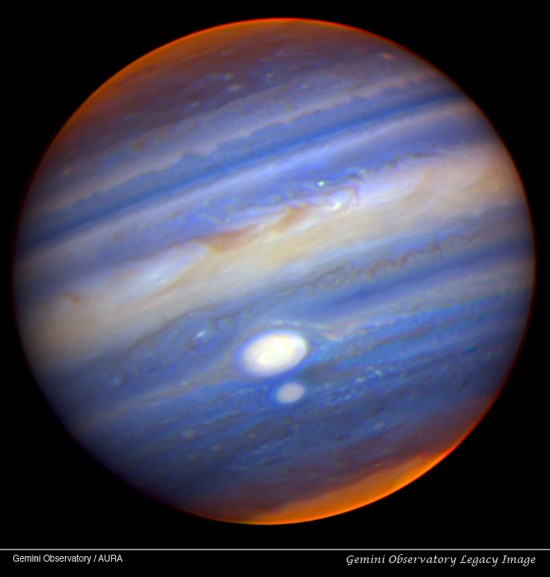
Jupiter in near-infrared. White is clouds at high altitude; blue is lower down; with red revealing even deeper clouds. Credit: Gemini Observatory ALTAIR Adaptive Optics Image.
Aug 14, 2015
One more year to go.
The dice of Zeus always fall luckily.
— Sophocles
NASA launched the Juno Mission to Jupiter on August 5, 2011. After traveling out past the orbit of Mars, the spacecraft returned for a gravity assist from Earth on October 9, 2013, then headed out to deep space. Rendezvous with Jupiter should take place in about one year on July 4, 2016. Upon arrival, the spinning satellite will enter a north-south polar orbit.
Juno is designed to explore Jupiter’s atmosphere: composition, temperature, cloud motions and other properties. It will also graph the giant planet’s magnetic and gravity fields, its magnetosphere, and its aurorae as it swings around Jupiter every 11 days. Since Jupiter rotates every 10 hours, a complete scan of the planet will be completed in 33 orbits. As of this writing, Juno is scheduled to plunge into Jupiter’s cloud tops in 2017.
A surprising press release from the Jet Propulsion Laboratory announced that Jupiter’s rings are electrically charged. Douglas Hamilton from the University of Maryland wrote: “On Jupiter’s day side, the sunlight charges the dust particles positively, while on the night side the particles carry a negative charge. Different charges react differently to Jupiter’s magnetic field, leading to changes in particle orbits, and when conditions are right, even the tilt or inclinations of the ring particles change.”
More than six years ago, the Picture of the Day addressed the “volcanic” plumes ejected from Jupiter’s moon, Io. Io is said to be “kneaded” by Jupiter’s gravity, causing charged particles to be ejected by said volcanic plumes. The ions flow in a circuit to and from Jupiter. Since they are electrically charged, those plasma discharges from the moon to the gas giant constitute a flow of electricity. Some planetary scientists have begun to acknowledge an electrical connection after Io’s “footprint” was seen in Jupiter’s polar aurorae.
All four of Jupiter’s largest moons were found to leave the shape of “tails” flowing within the plasma column in its aurorae. Later, when NASA launched New Horizons on a mission to study Pluto and Charon, the plumes of Tvashtar on Io were found to be filamentary in structure, with indications that they are actually corona arc discharges from the electric “hot spots” linking the moon with Jupiter.
Another aspect of Jupiter’s electrical nature is its rings, formed out of a thin sheet of material encircling the planet. The ring structure is quite diffuse, making observations difficult unless they are in correct alignment with the Sun. The outer radius begins at 129,000 kilometers, almost the same distance as the moon Adrastea. Consensus theories argue that the moons Metis, Adrastea, Amalthea and Thebe influence the structure of Jupiter’s rings in the same way that the “shepherd moons” of Saturn govern the shape of its huge ring formation.
Modern astronomers assume that the Universe is electrically neutral, so when observations confirm electrically active plasma, localized phenomena no matter how improbable are invoked. Tidal forces and volcanoes are presented as the cause and the evidence for electric circuits is ignored. In the case of Jupiter’s rings, the same thing is happening. The ring charge is said to be caused by sunlight and shadow rather than by an electrically active circuit between Jupiter and the Sun.
An electrical interaction between Jupiter and its moons means that they are charged bodies. Jupiter exists in a dynamic relationship to the Sun and it is now known that charged particles from the Sun and not “electric dynamos” power the planetary aurorae. Just like the aurorae, the ring system on Jupiter is probably behaving in similar fashion to what is seen on Saturn, so a similar explanation is most likely correct. Hopefully, Juno will provide enough data to push conventional thinking into an Electric Universe perspective.
Stephen Smith












